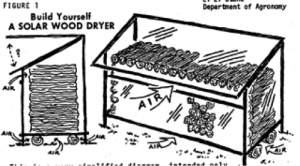Choosing Your Own Wood
When collecting your own wood, it is important to consider several things. If wood is lying on the ground in a woodland or park that has a owner, it belongs to the owner and if taken without their consent it is a criminal offence and classed as theft. This also applies to cut wood as it has probably been left there by a timber merchant who already has consent.
However, at one time, wood could be collected from a common or public land for personal use. This is called ‘estover’ rights. These days though, most of the public-owned land belongs to the Forestry Commission. In some areas, the Commission supply licences to allow people to collect wood; These generally cost a few pound (£) per year. In other areas, they hold roadside fireside sales.
If you follow the general rule of thumb to ask before you take, you can’t really go wrong.
Green wood = freshly cut wood.
Air dried = Wood left to dry in the natural air over several seasons.
Kiln dried = Wood dried artificially in ovens (kilns) over several weeks.
The Science Bit:
- Moisture Content.
- Wood Density.
- Collecting your wood.
- How to dry your logs.
This basically comes down to two factors, 1) Moisture Content, & 2) Wood Density. Both these factors have an effect on the Calorific Value (CV) or the amount of available heat per unit (volume) of fuel.
Moisture Content:
This is the part that has the most prolific effect on the CV. Any water in the wood has to be burnt away before the wood will burn which reduces the amount of energy released as useful heat.
If wet logs do actually light, they will smoulder and create smoke. It will also create tar which is very corrosive and will damage the chimney flue lining and increase the risk of chimney fire. Wet logs will also blacken stove glass.
Well seasoned or dried logs can have twice the CV as that of green or fresh logs. If a log is well seasoned, you will see radial cracks in the wood and any bark, if still attached, will come off easily.
The moisture content of a piece of wood is a measure of the relative weight of water and weight of the solid wood. This is either called ‘dry basis’ or ‘wet basis’.
Wood Density:
Wood comes in two types:
- Hardwood – deciduous, broadleaved tree: tend to be dense woods
- Softwood – evergreen, coniferous tree
So a tonne of hardwood logs will take up a smaller space than a tonne of softwood logs. Denser wood tends to burn longer requiring fewer top ups.
Collecting your wood:
Damp or green wood is difficult and inefficient to burn and contains between 65 – 95% water in its natural state. Therefore it needs drying.
Wood should be:
Felled by Spring/End of April (After baby birds have fledged)
Stacked by Summer
Covered by Autumn
Brought in by Winter
How To Dry Your Logs ♨
- Green logs will need stacking and drying before use.
- Felling timing is crucial so the logs will be at their driest during the winter. Some stoves require a moisture content of 20% or less…this could take up to 2 summers to achieve through air drying.
- Dry logs should be stacked off the ground to avoid the wood becoming rotten, ideally in a place with a waterproof cover with open sides. It should be sunny and in a windy position so the prevailing wind can blow through the stack.
- Logs cut/split with 10cm diameter or less to allow the moisture to move from the centre to the surface more easily.
- For optimum burning and lowest moisture content bring cut and split logs indoors a couple of days before use to help with the drying.




Should Wood Burning Stoves Be Sold with a Clear Health Warning?
/0 Comments/in Environment /by SuperadminFrom 2022, all new wood burning stoves must comply with the Clean Air Act. This is the same whether you live in the country surrounded by green pastures or in an urbane city environment.
The Best Artificial Logs for Wood Burning Stoves that You Can Buy in 2021
/0 Comments/in Top tips /by SuperadminLet’s face it, as aesthetically inviting to interior décor and comforting to the soul as a roaring fire can be, without the consistent warmth and crackle of a fire on a chilly spring evening, your wood burners won’t meet their purpose.